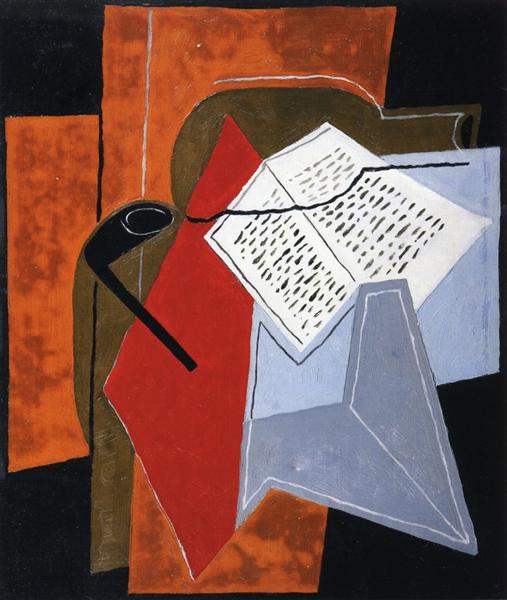説明
Juan Gris's "Bowl and Book", painted in 1927, is at the heart of the Cubist movement, of which Gris is one of the most prominent representatives. Through this painting, the artist not only offers us a static moment of an everyday object, but also invites us to reflect on form, light and colour.
From a compositional perspective, “Bowl and Book” presents a carefully balanced arrangement of elements. On the canvas, a predominantly yellow-hued bowl appears on the left, serving as a focal point that contrasts markedly with the serenity of the book, which is presented in a more restrained, almost grayish tone. The arrangement of these elements is intentional; the artist seeks not only to represent the objects realistically, but to break them down and reorganize them into a visual structure that provokes a reevaluation of their meaning. The fragmented, geometric form, characteristic of Cubism, allows the viewer to observe multiple perspectives within a single frame, a practice that is fundamental to Gris’s work.
Color plays a vital role in “Bowl and Book.” The palette is careful and controlled; the warm tones of the bowl contrast with the cooler tones of the book, creating a visual interplay that is immersive. The choice of orange-yellow for the bowl not only makes it stand out on the canvas, but also evokes a sense of warmth and familiarity, while the more muted tones of the book bring a sense of stability. This juxtaposition reflects the eerie serenity often found in Gris’s works, symbolizing the search for harmony in a world that is continually breaking down.
The use of space and texture is also notable. The surface of the painting seems endowed with a palpable physical dimension, where the bowl and the book are not mere objects, but elements that invite exploration. The representation of these flattened forms and their carefully delineated shading create a perception of depth and volume, elements that are characteristic of the formal development of synthetic cubism that Gris adopted in his work.
There are no characters in “Bowl and Book,” and this absence feels intentional, as a way of focusing on the object itself and its abstract surroundings. The removal of the human figure underscores the idea that the everyday, represented by common objects like a bowl and a book, can also be the subject of artistic reflection. Here, Gris invites us to rediscover the mundane through an artistic lens that itself challenges perception.
As part of his career, this painting is set at a time when Gris had already defined his style and emphasized the use of simplified forms and harmonious colors to explore the notion of reality. This connects him to contemporaries such as Pablo Picasso and Georges Braque, although Gris' voice is distinguished by a subtlety and melodic approach in his use of color that often feels more poetic and less aggressive than in the works of his peers. This characteristic of his style allows him to capture the meaningful essence of everyday objects, provoking in the viewer a sense of familiarity and nostalgia.
“Bowl and Book” is not only an exploration of cubism, but also a meditation on the act of observing. The work encapsulates a worldview in which the simple can become extraordinary, and in this sense it becomes a timeless work that continues to resonate with contemporary audiences. In his lines and colors, Juan Gris demonstrates that art can be a bridge between the everyday and the sublime, inviting everyone to look beyond the surface and find meaning in what is often considered trivial.
KUADROS ©, a famous painting on your wall.
Hand-made oil painting reproductions, with the quality of professional artists and the distinctive seal of KUADROS ©.
Painting reproduction service with satisfaction guarantee. If you are not completely satisfied with the replica of your painting, we will refund 100% of your money.

